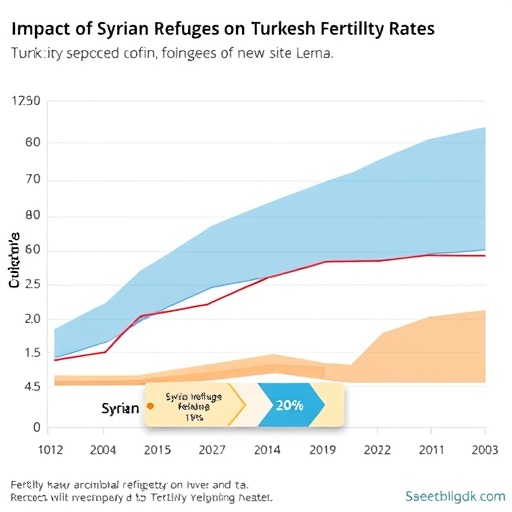In a groundbreaking new study published in the “Journal of Population Research,” researchers Özgür B. Soylu and Meltem Türel delve into the intricate dynamics surrounding the migration of Syrian refugees to Türkiye and its noteworthy implications on native fertility rates. The findings from their research provide significant insights that challenge previously held notions about the demographic impact of refugee influxes in host countries. As global migration patterns continue to evolve, understanding these phenomena is essential for policymakers and researchers alike.
The Syrian civil war has catalyzed one of the largest refugee movements in modern history, with millions spilling over borders in search of safety. Türkiye has been at the forefront, hosting millions of displaced Syrians, a situation that has triggered discussions about economic, social, and demographic challenges. Soylu and Türel’s work specifically zeroes in on the often-overlooked aspect of how such displacement affects fertility patterns within the native population.
Historically, demographics can shift dramatically during periods of significant migration. Sociologists and demographers have shown that influxes of refugees often lead to increased competition for resources. This competition, in turn, can influence family planning decisions among native populations. Soylu and Türel’s research adds a quantitative layer to this analysis, offering extrapolated data to examine fertility rates distinctly attributable to the Syrian refugee crisis within Türkiye.
The researchers employed data from various governmental and NGO sources to construct a comprehensive demographic profile. By correlating fertility rate changes with the arrival and settlement of refugees, they identified patterns that suggest a mild, but noticeable, decline in native fertility rates. This decline is particularly pronounced in urban areas, where the population density and competition for resources are markedly intensified. The implications of such a trend can spark concerns regarding the long-term sustainability of Türkiye’s population growth rates.
A substantial finding from their research indicates that the economic uncertainties brought about by the refugee crisis may have played a pivotal role in shaping the fertility decisions of native families. With increased costs of living and housing exacerbated by the influx of refugees, many native couples are re-evaluating their family planning strategies. It appears that financial strain—coupled with heightened competition for jobs—may be leading to postponements in starting families or opting for smaller family sizes among the Turkish populace.
The insights gleaned from this work are not limited to Türkiye alone but can resonate with other nations experiencing similar patterns of refugee migration. Countries like Lebanon and Jordan, which are also host to significant numbers of Syrian refugees, may see analogous demographic changes. This extension of research beyond the Turkish context highlights the necessity for broader, international discussions regarding refugee policies and their long-term demographic consequences.
Additionally, there are sociocultural dimensions that accompany the economic factors at play. Native families, under backdrop pressures of cultural shifts, may find themselves grappling with concerns surrounding their identity amid a rapidly changing demographic landscape. The blending of diverse cultures can create tensions that further influence family dynamics and decisions about childbirth, with native populations seeking to preserve their cultural heritage.
Soylu and Türel also emphasize the importance of understanding fertility patterns as a multifaceted interaction rather than a straightforward cause-and-effect scenario. This nuanced approach enables a more comprehensive understanding of how refugees influence local populations. It is critical for researchers to assess the interplay of various factors, including economic, social, and cultural variables, to develop a more holistic view of the repercussions associated with heightened immigration flows.
In framing their findings within the larger context of global migration, Soylu and Türel encourage policymakers to consider the demographic ripple effects of refugee movements. Proactive measures could facilitate smoother integration processes, allowing for shared growth and sustainability between native and refugee populations. Through effective policies, the potential negative consequences of refugee influxes can be mitigated, ensuring that both groups can thrive together in the long term.
There is, however, a silver lining within these challenges. The research posits that the integration of refugees may foster new forms of community and resilience that could, in the long run, enhance rather than hinder native fertility rates. A diverse community can cultivate an environment that encourages collaboration, innovation, and support—factors that can inspire families to feel more secure in their ability to have children.
In conclusion, the examination of fertility trends following the arrival of Syrian refugees in Türkiye highlights a vital intersection between demographics and sociopolitical dynamics. Soylu and Türel’s research unravels complex layers of interaction, revealing that the impacts of migration are profound and multifaceted. As Türkiye and other host nations navigate these waters, it becomes ever more crucial to inform policy with rigorous research so that the demographic balance can be sustained—benefiting both native populations and newcomers alike.
Through their findings, Soylu and Türel offer a clarion call for further studies in this domain. While the immediate effects on fertility rates are of significant concern, ongoing research will be paramount in understanding and addressing the long-term implications of migration in an increasingly interconnected world.
Subject of Research: The effects of Syrian refugees on native fertility in Türkiye.
Article Title: Beyond borders: exploring the effects of Syrian refugees on native fertility in Türkiye.
Article References:
Soylu, Ö.B., Türel, M. Beyond borders: exploring the effects of Syrian refugees on native fertility in Türkiye.
J Pop Research 42, 31 (2025). https://doi.org/10.1007/s12546-025-09380-3
Image Credits: AI Generated
DOI:
Keywords: Syrian refugees, native fertility, Türkiye, demographic impact, migration, socioeconomic factors.




